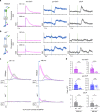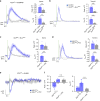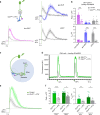Muscarinic acetylcholine receptor signaling generates OFF selectivity in a simple visual circuit
- PMID: 31501438
- PMCID: PMC6733798
- DOI: 10.1038/s41467-019-12104-w
Muscarinic acetylcholine receptor signaling generates OFF selectivity in a simple visual circuit
Abstract
ON and OFF selectivity in visual processing is encoded by parallel pathways that respond to either light increments or decrements. Despite lacking the anatomical features to support split channels, Drosophila larvae effectively perform visually-guided behaviors. To understand principles guiding visual computation in this simple circuit, we focus on investigating the physiological properties and behavioral relevance of larval visual interneurons. We find that the ON vs. OFF discrimination in the larval visual circuit emerges through light-elicited cholinergic signaling that depolarizes a cholinergic interneuron (cha-lOLP) and hyperpolarizes a glutamatergic interneuron (glu-lOLP). Genetic studies further indicate that muscarinic acetylcholine receptor (mAchR)/Gαo signaling produces the sign-inversion required for OFF detection in glu-lOLP, the disruption of which strongly impacts both physiological responses of downstream projection neurons and dark-induced pausing behavior. Together, our studies identify the molecular and circuit mechanisms underlying ON vs. OFF discrimination in the Drosophila larval visual system.
Conflict of interest statement
The authors declare no competing interests.
Figures








Similar articles
-
Direct observation of ON and OFF pathways in the Drosophila visual system.Curr Biol. 2014 May 5;24(9):976-83. doi: 10.1016/j.cub.2014.03.017. Epub 2014 Apr 3. Curr Biol. 2014. PMID: 24704075
-
Regulation of glutamate release from primary afferents and interneurons in the spinal cord by muscarinic receptor subtypes.J Neurophysiol. 2007 Jan;97(1):102-9. doi: 10.1152/jn.00586.2006. Epub 2006 Oct 18. J Neurophysiol. 2007. PMID: 17050831
-
Acetylcholine-dependent upregulation of TASK-1 channels in thalamic interneurons by a smooth muscle-like signalling pathway.J Physiol. 2017 Sep 1;595(17):5875-5893. doi: 10.1113/JP274527. Epub 2017 Aug 3. J Physiol. 2017. PMID: 28714121 Free PMC article.
-
Muscarinic modulation of striatal function and circuitry.Handb Exp Pharmacol. 2012;(208):223-41. doi: 10.1007/978-3-642-23274-9_10. Handb Exp Pharmacol. 2012. PMID: 22222701 Review.
-
Molecular properties of muscarinic acetylcholine receptors.Proc Jpn Acad Ser B Phys Biol Sci. 2013;89(6):226-56. doi: 10.2183/pjab.89.226. Proc Jpn Acad Ser B Phys Biol Sci. 2013. PMID: 23759942 Free PMC article. Review.
Cited by
-
Neurotransmitters Affect Larval Development by Regulating the Activity of Prothoracicotropic Hormone-Releasing Neurons in Drosophila melanogaster.Front Neurosci. 2021 Dec 17;15:653858. doi: 10.3389/fnins.2021.653858. eCollection 2021. Front Neurosci. 2021. PMID: 34975366 Free PMC article.
-
CRASH2p: Closed-loop Two Photon Imaging in a Freely Moving Animal.bioRxiv [Preprint]. 2024 Dec 13:2024.05.22.595209. doi: 10.1101/2024.05.22.595209. bioRxiv. 2024. Update in: Nat Commun. 2025 Jul 1;16(1):5950. doi: 10.1038/s41467-025-60648-x. PMID: 38826435 Free PMC article. Updated. Preprint.
-
Differentiation of Theta Visual Motion from Fourier Motion Requires LC16 and R18C12 Neurons in Drosophila.iScience. 2020 Apr 24;23(4):101041. doi: 10.1016/j.isci.2020.101041. Epub 2020 Apr 8. iScience. 2020. PMID: 32325414 Free PMC article.
-
A Plastic Visual Pathway Regulates Cooperative Behavior in Drosophila Larvae.Curr Biol. 2019 Jun 3;29(11):1866-1876.e5. doi: 10.1016/j.cub.2019.04.060. Epub 2019 May 23. Curr Biol. 2019. PMID: 31130457 Free PMC article.
-
Temporal regulation of nicotinic acetylcholine receptor subunits supports central cholinergic synapse development in Drosophila.Proc Natl Acad Sci U S A. 2021 Jun 8;118(23):e2004685118. doi: 10.1073/pnas.2004685118. Proc Natl Acad Sci U S A. 2021. PMID: 34074746 Free PMC article.
References
Publication types
MeSH terms
Substances
LinkOut - more resources
Full Text Sources
Molecular Biology Databases
Miscellaneous

